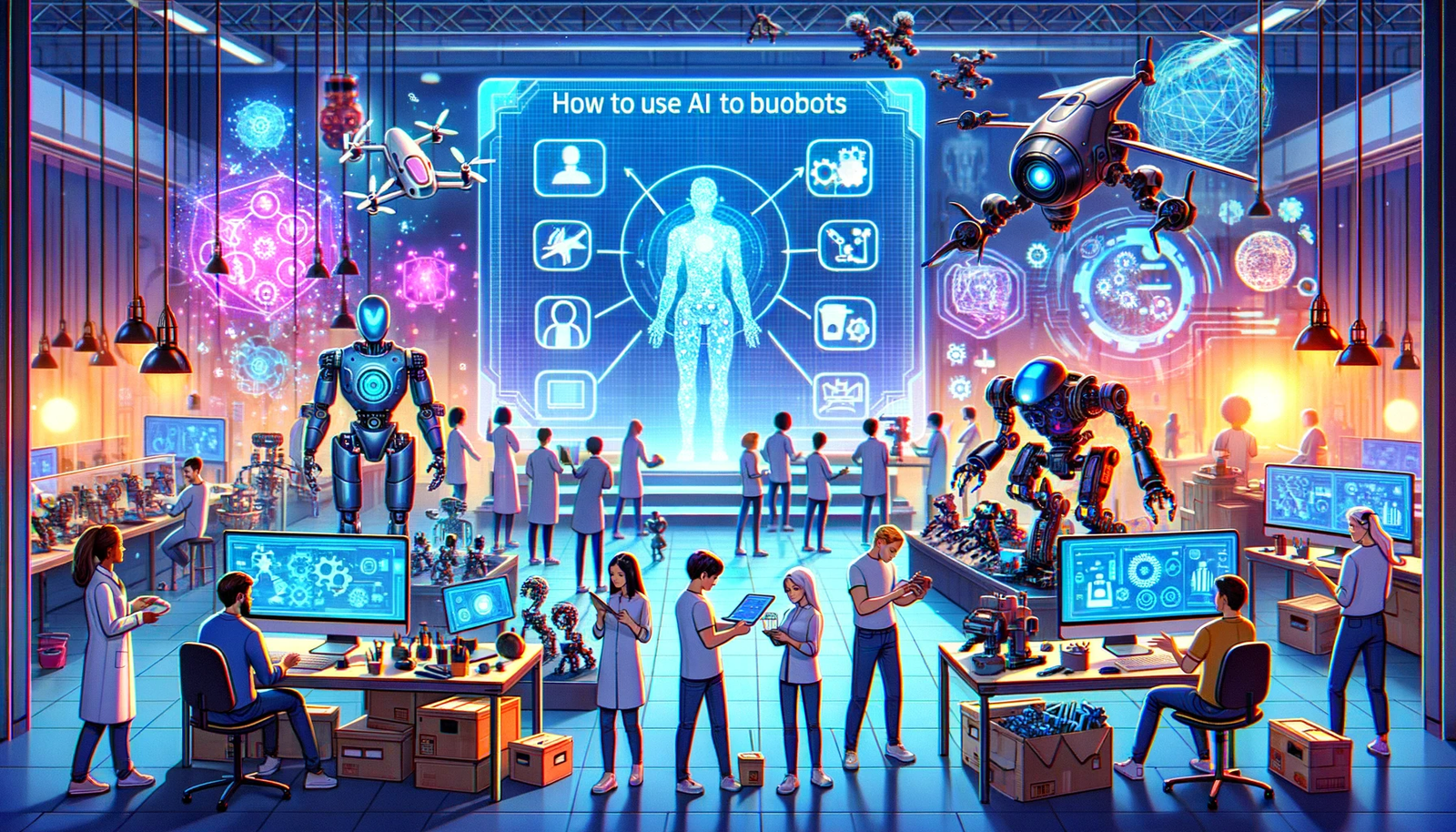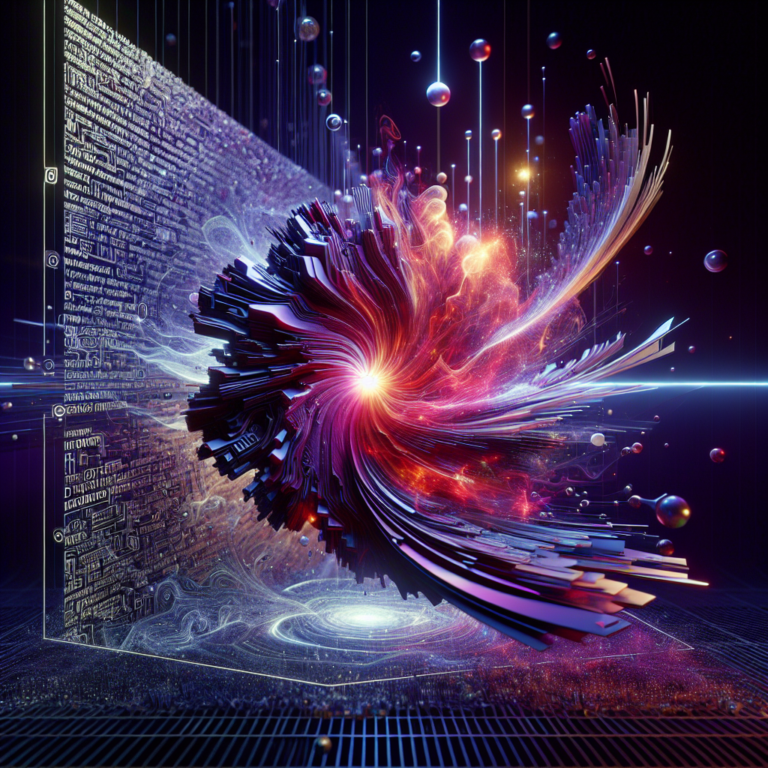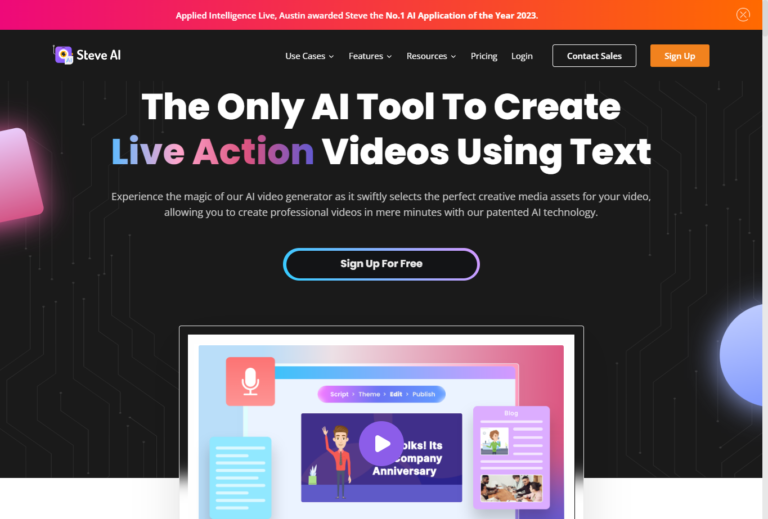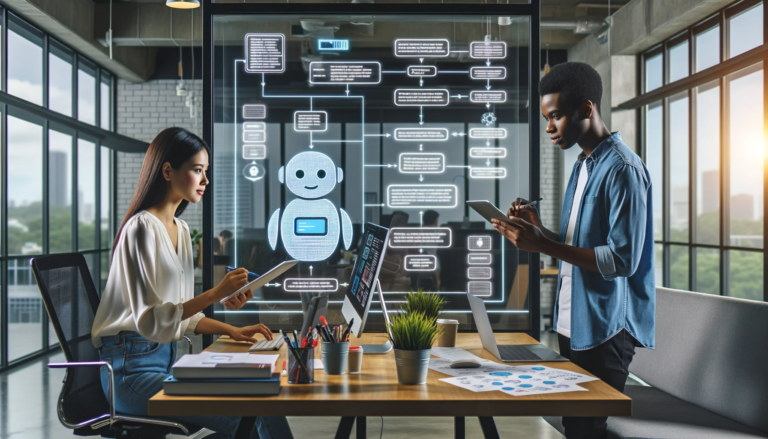
In today’s rapidly advancing technological landscape, the integration of artificial intelligence (AI) to build robots has become increasingly prevalent. From automated assistants to autonomous vehicles, AI is revolutionizing the way we interact with and perceive robots. In this article, we will explore the various ways AI is used in the construction and development of robots, highlighting its benefits, challenges, and potential implications for the future. So, if you’ve ever wondered about the inner workings of these intelligent machines, prepare to be captivated as we delve into the fascinating world of using AI to build robots. Get ready to unlock a whole new level of technological marvel!
Understanding the Basics of AI
Introduction to Artificial Intelligence
Artificial intelligence (AI) is a field of study that focuses on creating intelligent machines capable of performing tasks that typically require human intelligence. These machines, known as robots, are designed to simulate human actions and reasoning, allowing them to perform various functions and tasks autonomously. AI has been a groundbreaking development, revolutionizing industries and transforming the way we live and work. By understanding the basic principles and types of AI, you can delve into the exciting world of robotics and explore the endless possibilities that lie ahead.
Types of AI
There are various types of AI that can be applied to robotics. Firstly, we have Narrow AI, which is designed to perform specific tasks efficiently. Narrow AI systems are trained to excel at a particular job, such as playing chess or recognizing objects in images. On the other hand, we have general AI, which aims to mimic human intelligence across a broad range of tasks. General AI systems possess the ability to understand, learn, and apply knowledge to different scenarios. While General AI is still a goal for future advancements, Narrow AI has already made significant progress and is widely used in various industries.
How AI Can Be Applied to Robotics
AI plays a crucial role in the field of robotics, enabling robots to interact with their surroundings, make decisions, and perform tasks autonomously. By incorporating AI into robot design, we can create machines capable of understanding and learning from the environment, allowing them to adapt and improve over time. AI can be applied to robotics in several ways, such as designing the robot, training AI models, implementing AI in robot control systems, utilizing AI for localization and mapping, applying AI in computer vision, implementing AI in robot motion planning, deploying AI in robot speech and natural language processing (NLP), and employing AI for robot learning and adaptation. Each of these areas plays a vital role in the development and functionality of AI-powered robots.
Designing the Robot
Identifying the Purpose of the Robot
Before diving into the design process, it is crucial to identify the purpose of the robot. Determining the specific tasks the robot is intended to perform will guide the design decisions and help in selecting the appropriate components and features. Whether the robot is intended for industrial automation, healthcare assistance, or household chores, clarifying the purpose will ensure that the design aligns with the desired functionality.
Defining the Robot’s Physical and Functional Requirements
Once the purpose is identified, it is essential to define the physical and functional requirements of the robot. The physical requirements involve determining the size, shape, and mobility of the robot, considering factors such as the environment in which it will operate. Meanwhile, the functional requirements involve specifying the capabilities and functionalities the robot should possess, such as object manipulation, navigation, perception, and interaction with humans. Defining these requirements is crucial for designing a robot that meets its intended purpose effectively.
Choosing the Right Components and Materials
Selecting the right components and materials is a crucial step in designing a robot. The choice of components, such as motors, sensors, actuators, and processors, will directly impact the robot’s performance and capabilities. Furthermore, the materials used in the robot’s construction must be selected based on factors such as durability, weight, and cost-effectiveness. By carefully choosing these elements, you can ensure that the robot is equipped with the necessary tools to fulfill its designated tasks.
Considering Safety and Ethical Implications
Safety is of utmost importance when designing a robot. The robot’s design must prioritize the safety of both the robot itself and the humans it interacts with. This includes incorporating safety features such as emergency stop buttons, obstacle detection sensors, and fail-safe mechanisms to prevent accidents and ensure safe operation. Additionally, ethical considerations should be taken into account, such as ensuring the robot’s actions align with ethical standards and avoiding potential harm or discrimination. By addressing safety and ethical implications during the design phase, we can build robots that are not only efficient but also trustworthy and responsible.

Training AI Models for Robotics
Collecting and Preparing Data
Training AI models for robotics requires a significant amount of data. This data can come in the form of images, videos, sensor readings, or any other relevant information that helps the robot understand its environment. Collecting and preparing this data involves gathering diverse and representative samples that cover a range of scenarios the robot may encounter. Cleaning and annotating the data also plays a vital role in ensuring the accuracy and reliability of the AI models.
Choosing the Right Machine Learning Algorithm
There are various machine learning algorithms available, each suited for different purposes. When training AI models for robotics, it is essential to select the appropriate algorithm that best fits the task at hand. For example, tasks such as object recognition may require convolutional neural networks (CNNs), while reinforcement learning algorithms may be suitable for teaching the robot how to interact with its environment. Choosing the right algorithm is crucial for achieving optimal performance and accuracy in the AI models.
Building and Fine-Tuning the AI Model
Once the data and algorithm selection are complete, the next step is to build and train the AI model. This involves feeding the prepared data into the chosen algorithm and iteratively adjusting the model’s parameters to improve its performance. Fine-tuning the AI model involves optimizing its accuracy, speed, and efficiency. This process may require multiple iterations and experimentation to achieve the desired results.
Verifying the Performance of the Model
Before implementing the trained AI model into the robot, it is essential to verify its performance and assess its accuracy and reliability. This can be done through various evaluation metrics and techniques, such as calculating precision and recall scores or conducting real-world testing. Verifying the performance of the AI model ensures that it meets the desired standards and can effectively perform the intended tasks.
Implementing AI in Robot Control Systems
Integrating AI with Robot Hardware
Once the AI model is trained and verified, the next step is to integrate it with the robot’s hardware. This involves connecting the AI model with the robot’s motors, sensors, and other components to enable real-time interaction and decision-making. Integrating AI with robot hardware requires careful consideration of the compatibility and communication protocols between the AI system and the robot’s control systems.
Programming the Robot’s Control Algorithms
To implement AI in robot control systems, the robot’s control algorithms must be programmed to incorporate the AI model’s outputs. This integration allows the robot to interpret the sensory inputs from its environment, process the information using the AI model, and generate appropriate actions based on the desired tasks and objectives. Programming the control algorithms ensures that the robot can effectively utilize the AI model’s capabilities within its operations.
Developing Sensory Perception and Learning Capabilities
AI can enhance a robot’s sensory perception and learning capabilities, enabling it to understand and interact with its environment more effectively. By implementing AI algorithms such as computer vision or natural language processing, robots can perceive objects, recognize gestures, understand speech, and adapt to changing circumstances. Developing sensory perception and learning capabilities empowers the robot to navigate its surroundings, interact with objects and humans, and learn from its experiences.
Enabling Human-Robot Interaction
Human-robot interaction is a crucial aspect of robotics, and AI can greatly enhance this interaction. By incorporating AI into robot control systems, robots can understand and respond to human commands, gestures, or facial expressions. This enables seamless communication between humans and robots, making it easier for humans to work alongside robots and collaborate on various tasks. Enabling effective human-robot interaction promotes efficiency, productivity, and user satisfaction.
Ensuring Real-Time Responsiveness
Real-time responsiveness is essential in robotic systems, as it allows for quick decision-making and adaptation to dynamic environments. By implementing AI in robot control systems, robots can process sensory inputs, make decisions, and execute actions within the necessary time constraints. Ensuring real-time responsiveness requires optimizing the AI algorithms, hardware integration, and control algorithms to minimize latency and maximize the robot’s ability to act swiftly and accurately.
Utilizing AI for Robot Localization and Mapping
Understanding Simultaneous Localization and Mapping (SLAM)
Simultaneous Localization and Mapping (SLAM) is a technique used in robotics to enable a robot to navigate and map an unknown environment. SLAM involves the robot simultaneously estimating its own location (localization) and mapping the surrounding environment (mapping) using sensor measurements. By leveraging AI algorithms and sensor fusion techniques, robots can autonomously create accurate maps of their environment while determining their own position within that map.
Implementing SLAM Techniques
Implementing SLAM techniques requires the integration of sensor data, AI algorithms, and robot control systems. The robot’s sensors, such as cameras, LiDAR, or sonar, provide the necessary measurements for estimating its position and mapping the environment. AI algorithms, such as extended Kalman filters or graph-based methods, merge and process this sensor data to generate the most accurate map of the surroundings and the robot’s position within it. Implementing SLAM techniques enables robots to navigate and explore unknown environments with precision and accuracy.
Enhancing Robot Navigation and Mapping Accuracy
AI can play a significant role in enhancing robot navigation and mapping accuracy within SLAM. By utilizing advanced AI algorithms, robots can refine their position estimates, correct errors, and improve the accuracy of the generated maps. This can be achieved through techniques such as loop closure, which allows the robot to revisit previously visited locations and correct any accumulated errors in position estimation. Enhancing robot navigation and mapping accuracy enhances the robot’s ability to perform complex tasks, operate in unfamiliar environments, and navigate efficiently.
Overcoming Challenges in Dynamic Environments
Dynamic environments pose several challenges for robots utilizing SLAM techniques. Moving objects, changing lighting conditions, or dynamic obstacles can hinder accurate mapping and localization. AI algorithms can help overcome these challenges by enabling the robot to differentiate between static and dynamic elements in the environment, adapt to changes in lighting conditions, or predict and avoid moving obstacles. By incorporating AI into SLAM techniques, robots can navigate and map effectively, even in dynamic and unpredictable environments.
Applying AI in Computer Vision for Robotics
Introduction to Computer Vision
Computer vision is a branch of AI that focuses on enabling machines to interpret and understand visual information from images or videos. In robotics, computer vision plays a vital role in perceiving and interacting with the environment. By utilizing AI algorithms and techniques, robots can recognize objects, track movements, interpret gestures, and even discern facial expressions. Computer vision enables robots to extract meaningful information from visual data, allowing them to operate autonomously and interact effectively with their surroundings.
Object Detection and Recognition
Object detection and recognition is a fundamental task in computer vision for robotics. By incorporating AI algorithms such as convolutional neural networks (CNNs), robots can accurately detect and identify objects within their environment. This ability enables robots to interact with objects, manipulate them, or perform specific tasks based on object recognition. Object detection and recognition empower robots with the ability to understand their surroundings and make informed decisions based on visual cues.
Visual Tracking and Gesture Recognition
Visual tracking enables robots to follow and track the movement of objects or individuals within their field of view. By using AI techniques such as object tracking algorithms or neural networks, robots can track moving objects or people, enabling them to interact and navigate effectively. Gesture recognition, another aspect of computer vision, allows robots to interpret human gestures and perform appropriate actions based on these gestures. Visual tracking and gesture recognition enhance the robot’s ability to interact with humans and objects seamlessly.
Facial and Emotion Recognition
Facial and emotion recognition is an advanced application of computer vision in robotics. By analyzing facial features and expressions, robots can identify individuals and determine their emotional states. This ability allows robots to adapt their behavior and responses accordingly, making human-robot interactions more meaningful and personalized. Facial and emotion recognition brings a human-like element to robots and enhances their ability to understand and respond to human emotions.
Using AI to Enhance Vision Algorithms
AI can be applied to enhance vision algorithms used in robotics. Advanced AI techniques, such as deep learning, can optimize object detection and recognition algorithms, improve tracking accuracy, and enhance facial and emotion recognition systems. By utilizing AI, vision algorithms can continuously learn and adapt to new challenges or changing conditions, further improving the robot’s perception and interaction capabilities. Using AI to enhance vision algorithms ensures that robots can effectively interpret visual data and make informed decisions based on that information.
Implementing AI in Robot Motion Planning
Understanding Robot Motion Planning
Robot motion planning involves determining the optimal path or sequence of actions that a robot should take to achieve a particular goal or perform a task. This process considers factors such as the robot’s physical limitations, environmental constraints, and the desired outcome. By implementing AI in robot motion planning, robots can efficiently navigate their environment, avoid obstacles, and accomplish complex tasks.
Path Planning Algorithms
Path planning algorithms are essential in robot motion planning. These algorithms enable robots to calculate the most efficient and obstacle-free path from their current location to a desired destination. AI techniques, such as graph search algorithms or heuristic approaches, can be employed to optimize path planning and ensure that the robot takes the shortest and safest route. Path planning algorithms provide the foundation for successful robot navigation and enable efficient task execution.
Collision Detection and Avoidance
Collision detection and avoidance play a critical role in robot motion planning. By incorporating AI algorithms, robots can perceive their surroundings, detect potential obstacles, and adjust their path or actions to avoid collisions. This is achieved through real-time sensor data analysis, prediction models, or machine learning techniques. Collision detection and avoidance algorithms enhance the robot’s safety, prevent damages, and ensure efficient motion planning and execution.
Optimizing Motion Plans
AI can be utilized to optimize motion plans generated by path planning algorithms. Optimization techniques such as genetic algorithms or reinforcement learning can refine the robot’s path, adjusting it to minimize energy consumption, maximize speed, or optimize other performance metrics. By optimizing motion plans, robots can perform tasks more efficiently, conserve energy, and navigate their environment seamlessly.
Integrating AI for Adaptive Motion Planning
Adaptive motion planning involves allowing the robot to respond and adjust its movement based on real-time feedback from its environment. By implementing AI techniques, the robot can adapt its motion plans and actions to unforeseen or changing circumstances. This adaptability ensures that the robot can handle unexpected obstacles, changes in the environment, or dynamic situations. Integrating AI for adaptive motion planning empowers the robot to operate effectively in unpredictable and dynamic scenarios.
Deploying AI in Robot Speech and Natural Language Processing (NLP)
Introduction to Speech and NLP Technologies

Speech and Natural Language Processing (NLP) technologies play a significant role in enabling effective human-robot communication. By incorporating AI algorithms into robot systems, robots can understand human speech, interpret commands, and generate appropriate responses. Speech and NLP technologies bridge the gap between humans and robots, enabling seamless communication and collaboration.
Speech Recognition and Synthesis
Speech recognition and synthesis are key components of robot speech and NLP systems. By utilizing AI algorithms such as deep learning or hidden Markov models, robots can accurately recognize spoken words and convert them into text or meaningful commands. Conversely, speech synthesis allows robots to convert text or commands into spoken language, generating human-like responses. Speech recognition and synthesis technologies enable robots to understand and respond to human speech effectively.
Natural Language Understanding and Generation
Natural Language Understanding (NLU) and Generation (NLG) are advanced aspects of NLP in robotics. NLU enables robots to interpret and understand the meaning behind human speech, allowing them to grasp complex commands, questions, or context. NLG, on the other hand, enables robots to generate responses or output that closely resemble human language, making the interaction more natural and intuitive. Natural Language Understanding and Generation empower robots to engage in meaningful and intelligent conversations with humans.
Improving Human-Robot Communication
AI plays a critical role in improving human-robot communication through speech and NLP technologies. By continuously learning and adapting to human speech patterns, preferences, or context, robots can enhance their understanding and response generation. Advanced AI algorithms, such as transformer models or recurrent neural networks, can optimize speech and NLP systems, ensuring accurate interpretation, and generating natural and contextually relevant responses. Improving human-robot communication fosters better collaboration, productivity, and user satisfaction.
Overcoming Language Barriers with AI
Language barriers can hinder effective communication between humans and robots. However, AI can help overcome these barriers by incorporating translation algorithms or multilingual speech recognition and synthesis systems. By leveraging AI-powered language processing techniques, robots can understand and respond to various languages, transcending linguistic limitations. Overcoming language barriers with AI strengthens global accessibility and broadens the applications and impact of robotic systems.
Employing AI for Robot Learning and Adaptation
Approaches to Robot Learning
Robot learning involves the process of acquiring new knowledge or skills through interaction with the environment or human guidance. There are several approaches to robot learning, including supervised learning, unsupervised learning, and reinforcement learning. Each approach has its own strengths and applications, enabling robots to acquire new abilities and adapt to changing circumstances.
Reinforcement Learning
Reinforcement learning is a powerful technique used in robot learning. By employing AI algorithms, robots can learn from trial and error, receiving feedback and rewards based on their actions. Reinforcement learning enables robots to improve their decision-making and behavior over time, refining their strategies and achieving optimal performance. This approach is particularly effective in situations where the robot can interact with the environment and receive feedback based on the outcomes of its actions.
Transfer Learning
Transfer learning is a methodology that allows robots to leverage knowledge acquired from one task or domain to another. By applying AI techniques, robots can transfer the acquired knowledge, skills, or models from a source task to a target task, even if the two tasks are not directly related. Transfer learning enables robots to learn more efficiently, generalize knowledge, and adapt to new situations more effectively. This approach is valuable in situations where robots need to perform multiple tasks or operate in different environments.
Adapting to Changing Environments
AI can enable robots to adapt to changing environments by continuously learning and updating their models and behaviors. By incorporating adaptive learning algorithms or predictive models, robots can monitor and analyze changes in their surroundings, anticipate future events, and adjust their actions accordingly. Adapting to changing environments ensures that robots can maintain optimal performance, handle unpredictable situations, and respond effectively in dynamic scenarios.
Continuous Improvement through AI
AI’s ability to learn and improve over time allows robots to continuously enhance their capabilities and performance. By implementing mechanisms such as online learning or incremental learning, robots can update their models, algorithms, or behaviors based on new data or experiences. Continuous improvement through AI enables robots to stay up-to-date, learn from their mistakes, and optimize their performance throughout their operational lifespan.
Challenges and Future Directions
Ethical Implications of AI in Robotics
As AI continues to advance in robotics, ethical implications arise that must be considered. Ensuring that robots operate within ethical boundaries, respect privacy, and uphold moral values is crucial. Ethical frameworks and guidelines need to be established to govern the development and deployment of AI-powered robots. This includes addressing issues such as bias, transparency, accountability, and the potential social impact of robots in various domains.
Addressing Bias and Accountability
Bias is a significant concern in AI-powered robots that rely on algorithms trained on biased data. Efforts must be made to identify and address biases to ensure fair and unbiased decision-making by robots. Accountability is also a critical aspect. Establishing mechanisms for testing, auditing, and ensuring the transparency of AI models and algorithms can hold developers accountable for the behavior and actions of AI-powered robots.
Ensuring Safety and Trustworthiness
The safety of AI-powered robots is paramount, especially as they operate in proximity to humans. Ensuring safety involves incorporating fail-safe mechanisms, emergency stop functionality, and robust error handling to prevent accidents or harm. Trustworthiness is also essential for user acceptance and confidence in robotic systems. Developing transparent and explainable AI algorithms, providing clear and reliable information about the robot’s capabilities and limitations, and establishing regulations and standards can foster trust and enable safe human-robot interaction.
Human-Robot Coexistence and Collaboration
The future of robotics lies in harmonious coexistence and collaboration between humans and robots. AI can bridge the gap between humans and robots, allowing for seamless interaction, effective collaboration, and distributed intelligence. Ensuring that robots are designed with a human-centered approach, respecting human values, and supporting human capabilities are crucial factors in building successful human-robot partnerships.
Build Robots
The field of AI and robotics is constantly evolving, with advancements being made in various domains. From more sophisticated AI algorithms to novel robotic hardware and sensing technologies, the future holds immense potential for AI-powered robots. As technologies improve, the barriers to integrating AI into robotics are gradually diminishing, paving the way for more intelligent and capable robots that can transform industries, improve productivity, and augment human abilities.
In conclusion, understanding the basics of AI and its application in robotics is essential for unlocking the full potential of intelligent machines. By comprehending the different types of AI, designing robots with careful consideration of their purpose and requirements, training AI models, implementing AI in robot control systems, utilizing AI for localization and mapping, applying AI in computer vision, implementing AI in robot motion planning, deploying AI in robot speech and NLP, employing AI for robot learning and adaptation, and addressing the challenges and future directions, we can shape a future where AI and robotics work hand in hand to enhance our lives and push the boundaries of technology.






